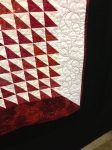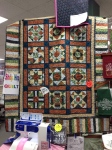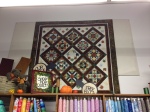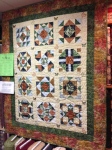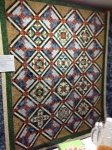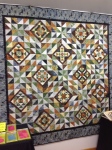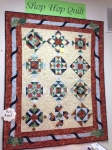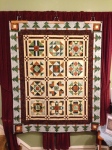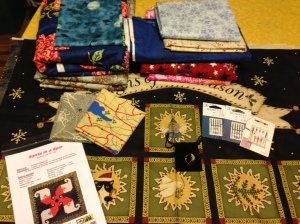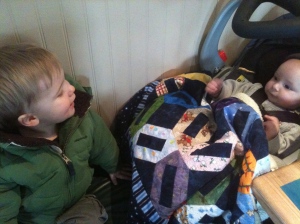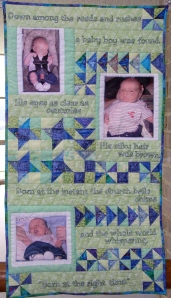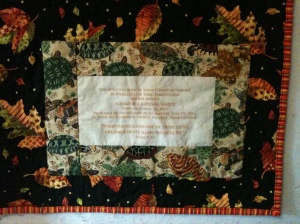Posts filed under ‘New Projects’
Finished! Denim Rag Quilt
This was a fun little project.
My mom and I had taken a class, probably ten years ago, on flannel rag quilts at Ladyfingers. I’m not even sure where that project bag is at this point. Suffice to say, I was not a fan. The instructor kept emphasizing how this was a quilt for people who didn’t care about accuracy, that “anything goes” with rag quilts, and if things didn’t line up, don’t worry because it wouldn’t matter. And while this approach may set some beginning quilters at ease, it was simply not what I wanted to hear at that stage of my quilting journey. I was just starting to feel like a decently competent piecer, achieving a fairly consistent 1/4″ seam and matching my intersections most of the time. The last thing I needed was a project in which precision was not only NOT a goal, it was a liability. (The ridiculous stretchiness of the flannel I was using meant that nothing stayed square, straight, or remotely the same size, even with a walking foot.) Throw in the fact that I was really not looking forward to clipping all those seams once the darn thing was finished, and this was a project born to become a UFO.
*Little bit of a tangent here: although the instructor for the flannel rag quilt class was very nice and very competent as an instructor, it was clear she and I were not on the same quilting wavelength. While we were working on our squares, she talked about how she designs quilts for fabric companies, incorporating entire lines of fabric for them. All well and good and very interesting. However, she then went on to say that she plans everything out in advance for all her quilts, not just those, and that she has NO STASH. Let that sink in for a minute. In fact, she said she had recently purchased 3 yards of a fabric that she planned to use as a border, and when it became clear that it would not indeed work as the border for this particular quilt, she was very upset because “now what am I going to do with it?” I absolutely could not relate.
After that experience, I can confidently state that I had given absolutely no thought to ever making another rag quilt until I started researching the purchase of my GO! cutter. Accuquilt makes rag dies that precut the fringes on the edges of the squares so that all you have to do is sew the blocks together and then wash the quilt: no hand-crippling, mind-numbing seam clipping to do! I still was in no hurry to work with flannel again, but I knew I had a stack of Dan’s worn-out jeans in the basement that were guilt-tripping me and making me feel like a hoarder, and the wheels started turning.
I had started saving the jeans after seeing a show on DIY or HGTV in which they discussed sustainable building practices including the use of recycled denim to make housing insulation. On the show, they promoted a recycling program that was doing drives throughout the country to collect the jeans. However, by the time I had any to contribute, the website said that drives were temporarily suspended for the year, and would I like to get on an email list for when they restarted? I did, but that was an email that never came. Since then, the only comparable program I’ve been able to find is Cotton: From Blue to Green, which only accepts mail-in denim donations. And they’re in Phoenix. I can’t imagine how expensive it would be to ship a big cardboard box of jeans to Phoenix, and I can’t imagine the carbon footprint of that decision would end up being particularly sustainable. So the jeans sat in my basement.
I had seen a magazine photo several years ago of a large denim picnic quilt, but had dismissed the idea for my own projects because the denim would be so heavy and difficult to work with. The die cutting definitely solved part of the problem; I had initially envisioned making the quilt much larger, but I only had six pairs of jeans to work with. (I think there are more in the basement somewhere, but these were the ones I could put my hands on.) In the event, I was fortunate to have the size limited by the amount of materials, because the 6 x 6 block quilt was heavy enough that my arms felt fatigued after putting it through the machine to join the last rows together.
I love the idea of a denim quilt for outdoors. I don’t scruple to take my regular quilts outside; I made them for my kids and I would rather they use and enjoy them, even if it means the quilts occasionally get a little dirty or abraded. However, a denim quilt is durable, HEAVY (having trouble keeping the child in bed? Lay one of these puppies on top of him!) and only improves with washing and wear, so it’s a natural for more rough-and-tumble settings. We really enjoyed attending some of the free outdoor family movies shown in Farquhar Park this summer, and quilts always came with us.
This one got to make its useful debut as a roll-around quilt for Finley as we ate our picnic lunch at Knoebel’s:
As to the actual construction of the quilt, I “deboned” the jeans, cutting each pair with dressmaker’s shears into two leg fronts and two leg backs by just cutting along the seam lines. I then removed the fly and the back pockets. (I had wanted to keep the pockets on the squares and thus have some blocks with usable pockets on the quilt, but the pockets on these jeans were too large and too close to the back yoke seam for that to work on this project. A future quilt made with different jeans, perhaps some of Ronan’s, will have pockets.) I then fed the resulting long denim pieces through the die cutter, only cutting one layer at a time since the fabric is so heavy. While cutting the squares individually and having to pull denim threads out of the die after each cut made this process much more time consuming than the typical die-cut project, it was still orders of magnitude faster than cutting all those fringes by hand. I was able to get 14 8.5″ squares (6.5″ finished due to the 1″ seam allowance), or 7 blocks, from each pair of jeans. Although there were plenty of oddly-shaped scraps that couldn’t be utilized for this project, I was also able to save 4 pieces (including the 2 back pockets) from each pair big enough to cut a 5.25″ rag square from once I purchase that die.
I was able to die cut the 6.5″ batting squares as well; this is a perfect project for using up those long odd leftover pieces of batting. I also cut 6 squares of the orange batik, and then die cut the Funky Flower out of the corresponding denim squares for a raggy reverse applique. I used a cute primary variegated YLI Jeans Stitch I’d had for years for the quilting, simple X’s in the plain blocks and echo quilting around the flowers. I used the walking foot for the quilting, but I found I had to switch back to my regular foot for joining the blocks because I skipped too many stitches otherwise. All those layers of denim are no joke: I even broke two #100 denim needles on this project.
The amount of lint when I washed it was ridiculous. I had heard that you should always clean the dryer lint filter mid-cycle when washing a flannel rag quilt. However, even pulling this one out of the washer involved handfuls of wet lint and a moment of panic that the whole quilt might have somehow disintegrated in the wash cycle.
Now to wrap this post up on an appropriately bizarre note, my sister Eleanore sent me the following text yesterday morning:
And some people think quilting is a boring hobby for mousy little homebodies. I like to think I’m keeping them guessing.
I Got An AccuQuilt GO! Cutter!
 And just like Finley here, I’m so excited about my toy!
And just like Finley here, I’m so excited about my toy!
I had heard a lot about the GO! cutter when it first came out, because Alex Anderson and Ricky Tims are spokespeople for it, with promotional videos on The Quilt Show site. While I’ve long been intrigued by fabric die cutters, ever since first visiting the fabulous home quilting studio of a guild friend who has the Accuquilt Studio cutter, I didn’t really think of it as being a priority item for me. I thought maybe it might be worthwhile for someone who does an awful lot of applique, but I don’t, and on the odd occasion when I do, I tend to design my own. So while I was glad to know there were die cutters in the world, I didn’t really covet one.
 Until… I had stopped by The Finishing Stitch on my way home from a wedding the day before Mother’s Day, and they had a Studio cutter and dies for sale for $600, listed as a $1500 value. A discount that steep is always going to pique my interest, but Finley was getting fussy so I didn’t investigate in depth. However, I started thinking about it more on the way home, and therefore spent some time on the Accuquilt website over the rest of the weekend. The main thing that I learned was how many piecing dies are available. As I am primarily a piecer, and cutting fabric has always struck me as tedious, this was very intriguing. Although a separate die is necessary for each different size or shape, I certainly tend to use certain shapes and sizes repeatedly in my projects (2″ finished half-square triangles certainly spring to mind.) And the idea, reiterated over and over on the website, that die cutting is “up to 90% faster than rotary cutting,” was extremely attractive to a full-time-working mom of two children under 3.
Until… I had stopped by The Finishing Stitch on my way home from a wedding the day before Mother’s Day, and they had a Studio cutter and dies for sale for $600, listed as a $1500 value. A discount that steep is always going to pique my interest, but Finley was getting fussy so I didn’t investigate in depth. However, I started thinking about it more on the way home, and therefore spent some time on the Accuquilt website over the rest of the weekend. The main thing that I learned was how many piecing dies are available. As I am primarily a piecer, and cutting fabric has always struck me as tedious, this was very intriguing. Although a separate die is necessary for each different size or shape, I certainly tend to use certain shapes and sizes repeatedly in my projects (2″ finished half-square triangles certainly spring to mind.) And the idea, reiterated over and over on the website, that die cutting is “up to 90% faster than rotary cutting,” was extremely attractive to a full-time-working mom of two children under 3.
After all, although I know it’s an all-too-temporary stage, I don’t have a whole lot of free time to quilt right now. It’s a trade-off I’m more than happy to make to be involved in Ronan’s and Finley’s young childhood, but I don’t want to completely swear off quilting right now. (And several of the quilts I’ve made in the last few years have been for them, and they enjoy using them!) So anything that speeds the process without decreasing my artistic freedom or my enjoyment of the process is a good thing. I have no interest in using pre-cut kits because my favorite part of quilting is selecting the fabrics, but if I can choose my own fabric and then fast forward to the construction stage without spending such a long time cutting the fabric into pieceable shapes, I will get a lot more done. Additionally, I haven’t wanted to do much cutting when Ronan is awake, because I have an absolute paranoia that he could get hold of the rotary cutter. While there are still blades in the die boards, he would have to do handstands on them in order to hurt himself with them.
 So Monday morning, I called Jean… and she told me that she was sorry, she should have taken the signs down, because she was selling the Studio cutter to the new owner of the shop as part of the shop sale. Having just spent the last 36 hours convincing myself that I desperately wanted this thing, it was definitely a letdown. But like Aesop’s fox with the grapes, I quickly recovered by realizing that the Studio would not have been the right choice for me. While it can cut more layers at once, and the dies are more numerous, varied, and larger, the dies are more expensive and the cutter requires a dedicated space, as it is heavy and does not fold up. It really seems like the good folks at Accuquilt really thought about all the factors that prevent quilters from buying a Studio cutter, and designed the GO! to meet those needs. I took my time researching the products and prices (another GO! advantage, as the Studio and its dies are only available through Accuquilt), then finally pulled the trigger in mid-July.
So Monday morning, I called Jean… and she told me that she was sorry, she should have taken the signs down, because she was selling the Studio cutter to the new owner of the shop as part of the shop sale. Having just spent the last 36 hours convincing myself that I desperately wanted this thing, it was definitely a letdown. But like Aesop’s fox with the grapes, I quickly recovered by realizing that the Studio would not have been the right choice for me. While it can cut more layers at once, and the dies are more numerous, varied, and larger, the dies are more expensive and the cutter requires a dedicated space, as it is heavy and does not fold up. It really seems like the good folks at Accuquilt really thought about all the factors that prevent quilters from buying a Studio cutter, and designed the GO! to meet those needs. I took my time researching the products and prices (another GO! advantage, as the Studio and its dies are only available through Accuquilt), then finally pulled the trigger in mid-July.
 My GO! came in the mail July 23, the Tuesday before my mini-retreat at my house with Rhonda and Diane. I bought it from quilting-warehouse.com which offers significant discounts (30-50%) on the GO! and several selected dies, and although the shipping was expensive and the order took longer than their stated estimate to process, I cannot complain in light of the overall value. I got the 12″ block “mix and match” bundle, which is a collection of eight dies for shapes commonly found in 12″ pieced blocks. I also got some extra cutting mats, the 8.5″ rag square, which precuts the fringes for rag quilts (more on that later), the Funky Flower applique shape, and the 3.5″ mini tumbler, since I’m getting a new niece and a new nephew this fall who will each be in need of a baby quilt. With shipping, this all came to less than $450; accuquilt.com lists the cutter with the 12″ bundle alone at $581.90.
My GO! came in the mail July 23, the Tuesday before my mini-retreat at my house with Rhonda and Diane. I bought it from quilting-warehouse.com which offers significant discounts (30-50%) on the GO! and several selected dies, and although the shipping was expensive and the order took longer than their stated estimate to process, I cannot complain in light of the overall value. I got the 12″ block “mix and match” bundle, which is a collection of eight dies for shapes commonly found in 12″ pieced blocks. I also got some extra cutting mats, the 8.5″ rag square, which precuts the fringes for rag quilts (more on that later), the Funky Flower applique shape, and the 3.5″ mini tumbler, since I’m getting a new niece and a new nephew this fall who will each be in need of a baby quilt. With shipping, this all came to less than $450; accuquilt.com lists the cutter with the 12″ bundle alone at $581.90.
 I spent all my work time at the retreat cutting: I cut almost all the pieces for the 2011 Shop Hop blocks; cut down several pairs of Dan’s old worn-out jeans to make a denim rag quilt; and cut 17.5 yards of solids into triangles for the guild challenge this winter. Although I didn’t get to work uninterrupted (see above re: two children under 3), I estimate that it took me less than 3 hours to cut all that solid fabric, so I stand convinced.
I spent all my work time at the retreat cutting: I cut almost all the pieces for the 2011 Shop Hop blocks; cut down several pairs of Dan’s old worn-out jeans to make a denim rag quilt; and cut 17.5 yards of solids into triangles for the guild challenge this winter. Although I didn’t get to work uninterrupted (see above re: two children under 3), I estimate that it took me less than 3 hours to cut all that solid fabric, so I stand convinced.

This happened within minutes of taking the picture above. Technology may change, but some other things never do.
I’ve only started piecing the shapes I cut, so I can’t say anything definitive, but so far the accuracy seems excellent. There’s definitely a learning curve to using the cutter, but I’ve caught on quickly. And if using it means I get to spend more of my admittedly limited time on the parts of quilting I enjoy more than cutting fabric, I’m all for it.
Next up, a project I’ve already started and completed with my GO!
FINISHED!!! Finley’s Quilt
I managed to finish Finley’s quilt before she was four months old!
I can technically claim I started this quilt while in the process of giving birth to her. When I was in a holding pattern at Labor and Delivery, hooked up to the monitors with my IV started, I found myself all worked up with nothing to do. I had filled out all the forms they had given me; I had handed off my phone to Dan so it wouldn’t go missing (no pockets in a hospital gown, go figure); and I had no one to talk to, because Dan and my parents were working out the logistics of who would be with Ronan at various points throughout the day’s events. So, to keep myself amused and centered, I started to do math longhand.
 I had seen this Rolling Stone quilt (Emeralds, by Mary Fons) on the cover of Fons and Porter’s Love of Quilting magazine, and thought it would be perfect. I wanted to use stash fabric, and I didn’t have an appropriate focus print handy like I had for Ronan’s quilt. However, I didn’t want to make it exactly as written, because as I’ve stated previously, I try to avoid the “corner cutter” methods when possible; I find them to be wasteful of fabric, and I’m an accurate enough piecer for my purposes that I don’t need to avoid cutting triangles. So I did my calculations for the pieces I would need to cut, and kept my mind largely occupied until they were ready to wheel me to the operating room.
I had seen this Rolling Stone quilt (Emeralds, by Mary Fons) on the cover of Fons and Porter’s Love of Quilting magazine, and thought it would be perfect. I wanted to use stash fabric, and I didn’t have an appropriate focus print handy like I had for Ronan’s quilt. However, I didn’t want to make it exactly as written, because as I’ve stated previously, I try to avoid the “corner cutter” methods when possible; I find them to be wasteful of fabric, and I’m an accurate enough piecer for my purposes that I don’t need to avoid cutting triangles. So I did my calculations for the pieces I would need to cut, and kept my mind largely occupied until they were ready to wheel me to the operating room.
 Needless to say, I didn’t start to actually cut and piece the quilt until Finley was a few weeks old. Since I was making thirteen blocks, I pulled twenty-six pink and purple fabrics from my stash and cut 2 rectangles and 2 square-in-a-square pieces from each. Then from half of them, I cut an additional square for the block centers. I cut the background triangles and rectangles from eight light taupe fabrics, and then pieced everything together into component units. I didn’t plan the individual blocks until I had already pieced all the square-in-a-square units and rectangle squares, so when I laid out the blocks (my favorite part!) I couldn’t always achieve my goal of keeping similar fabrics as far apart from one another as possible. Still, most of the blocks avoid repeating fabrics.
Needless to say, I didn’t start to actually cut and piece the quilt until Finley was a few weeks old. Since I was making thirteen blocks, I pulled twenty-six pink and purple fabrics from my stash and cut 2 rectangles and 2 square-in-a-square pieces from each. Then from half of them, I cut an additional square for the block centers. I cut the background triangles and rectangles from eight light taupe fabrics, and then pieced everything together into component units. I didn’t plan the individual blocks until I had already pieced all the square-in-a-square units and rectangle squares, so when I laid out the blocks (my favorite part!) I couldn’t always achieve my goal of keeping similar fabrics as far apart from one another as possible. Still, most of the blocks avoid repeating fabrics.
Originally, I had imagined using another light taupe for the setting triangles, but when I actually tried it on the design wall, it really washed out the blocks. From there I tried a taupe and wasabi green floral on a light background, and if anything, that was worse. But that inspired me to try a very odd fabric that I’d bought some time ago to coordinate with some of my dark taupes that had wasabi green highlights. It’s from the Odyssea collection by Moda, and as soon as I put it up on the design wall with the blocks I knew I had a winner.
The only downside was that I didn’t have enough for the corner triangles. However, even that became an opportunity because it gave me a place for applique. This was the only new fabric I bought for this quilt, as I didn’t have a tone-on-tone or solid in the same green. Searching for that was the impetus behind Finley’s and my first Mommy-daughter trip to the fabric store.
I appliqued Finley’s initials, as I had done with Ronan’s quilt, in the upper left corner, and used the remaining three corners for her birthdate and two swirly hearts based on the design on a yoga t-shirt I have. In the interests of time I just did fusible applique with a mini zigzag in matching thread, and then quilted the daylights out of them. Those appliques are not going anywhere.
I managed to finish piecing the quilt before my maternity leave ended April 8th and I went back to work. I used the rejected taupe and green floral for the back (after all, it matches!) using the remnants of the green from the corners and a rejected green pin dot to stretch it to fit. The quilting was a mix of my old standbys and some new techniques; I did freehand flowers and leaves in the pink and purple rectangles and square-in-a-squares. I wanted to emphasize the illusion of circles created by the straight line piecing of the Rolling Stone block, so I quilted freehand feather wreaths in the center of each block, marking only the circular spines. I then filled in the other background shapes with pebble filler. I quilted the setting triangles with a 60-degree grid of serpentine lines, using the centers of the flowers in the fabric print as my guides. The corners got freehand mini Baptist fans with strings of pearls in the applique.
I left the center squares unquilted, both to avoid obscuring the print and because I couldn’t decide what the best design for them would be. I’ve been heavily influenced lately by Wendy Sheppard’s Ivory Spring quilting blog; she does gorgeous, creative, prolific work on a domestic sewing machine. She frequently leaves much larger pieced areas unquilted than I’m used to seeing, adjacent to elaborately quilted designs, so I thought I could do a lot worse than to emulate this in my own work. As of now, I think it’s successful! And there’s the additional advantage that if at any future point I change my mind, I can always add more quilting. After all, I learned my lesson from Alice in Wonderland:
`I’ve had nothing yet,’ Alice replied in an offended tone, `so I can’t take more.’
`You mean you can’t take LESS,’ said the Hatter: `it’s very easy to take MORE than nothing.’
I finished the quilt with a binding with inserted rickrack, using Susan Cleveland‘s technique, as I thought it added an appropriate element of whimsy.
And the quilt was done in time for Show & Tell at the June quilt guild meeting, a full week before Finley turned four months old. I think a happy dance is in order, don’t you?
I’ve gone to the Silly Symphonies well before for these video links, and this one from 1933 is esthetically beautiful, delightfully bizarre and, appropriately for this post, baby themed:
Orphan Block Guild Challenge
Obviously, it’s been a really long time since I posted. I had intended on taking the summer off from blogging, but I didn’t mean to let it drag so far into fall. However, Hurricane Sandy closed my office on Monday, and since the power at home stayed on, I got some good momentum going on this post before normal life resumed.
Part of what has kept me quiet was the fact that until very recently I literally couldn’t talk about the main project that has occupied me since July: the guild challenge. This year’s theme was orphan blocks. We randomly drew bags that contained anything from a single orphan block to a collection of blocks or precut pieces, and then had to make something new out of the bag’s contents. My bag had just one single block in it, and it had issues:
In the plus column, it’s a 54-40-or-Fight block, which I’ve always liked the looks of but had never made; the basic color palette had promise, since purple and green are two of my favorite colors; and the fact that it was primarily made of solids meant that finding coordinating prints would be relatively simple. HOWEVER, I completely understand why this block ended up an orphan. It’s hand pieced, and the seam allowances were positively enormous, in the 1/2″ to 5/8″ range. There were rust stains, probably from being stored with needles or pins in it, and this block did not have a single 90-degree angle to its name. If I had made a block like this, I would have stopped at one, too. I salute the brave quilter who not only held onto this block for some years, but offered it up for public consumption. And I have to say, it inspired me to make something I’m very proud of, that I never would have conceived of otherwise.
My first thought was to just rip out the seams and use the individual pieces for applique. Heck, with those seam allowances, I certainly would have ended up with plenty of fabric! But ultimately, I decided I really wanted to maintain the sharp points of the original block and riff off of those for my final design.
A brief aside regarding my conflicted relationship with foundation paper piecing. I absolutely love “sharp pointies” designs such as New York Beauty and Mariner’s Compass, and paper piecing definitely seems to be the way to go to achieve satisfactory results with these blocks. However, I really don’t enjoy the process that much. I’ve tried several different books’ and teachers’ methods for paper piecing, I’ve tried several different types of paper foundations, and I still just find it to be tedious. I don’t like sewing on paper because the presser foot slips around, I despise having to trim after each seam, and I HATE having to tear the paper off afterwards. But in order to achieve the results I want with those super-sharp points, it’s what I have to do, and I’ve made peace with that. It will just never be my favorite technique.
I’ve had a book in my collection for many years, “Quilt Mavens: Perfect Paper Piecing” by Deb Karasik and Janet Mednick, whose pictures I have (metaphorically) drooled over for as long as I’ve had it. Up until now, though, I’ve never had occasion to make any of the patterns from it. But strangely enough, their pattern “Spike Redux,” which is essentially a giant Lemoyne Star by way of the Chrysler Building, seemed to echo the sharp points of the 54-40 or Fight block while introducing new design elements. I just changed the color and value distribution to suit myself, and swapped out the corner New York Beauty-style blocks for the orphan block.
I had bought the beautiful, hand-dyed-look, gradated purple and green fabric, “Glacier Lake” by Caryl Bryer Fallert, at least eight years ago. (I found it on the enclosed porch of the old location of Endless Mountains Quiltworks, so it’s been a while.) It was love at first sight, but it’s been one of those “too good to cut” fabrics for me all these years. With this color palette pre-established, I had finally found its showcase in the big setting triangles and curving center pieces. I only had a yard and a half, so I had to cut carefully, and I only have a few scraps left after just barely having enough to make the binding, but it was the perfect fabric for the job. In fact, most of the fabrics for this project came from my stash; the only ones I had to shop for were the pale lavender and pale chartreuse, because I needed lights for value contrast, and these are not shades that naturally occur in my collection. Fortunately, my mini-retreat with Rhonda and Kathy occurred just when I was about to embark on this project, so a shopping trip to Sauder’s did the trick.
The only part of the quilt that I hadn’t completely pre-planned before starting to cut fabric was the corner blocks. Initially I had considered leaving the block intact and just making three more like it (obviously machine pieced and with new fabrics), but I was concerned that wasn’t changing it enough for the spirit of the challenge. Also, having three identical blocks and one “vintage” block would probably tend to draw focus to the odd one out, like that old song from Sesame Street:
So I tried cutting the blocks in half diagonally, although I flipped the orientation after playing around on the design wall. I experienced a great deal of stress when finally rotary cutting that block, because it was the only one I had — normally the worst thing that could happen is that I’d have to recut or repiece, but the stakes were high on this! Plus, those hand-pieced seams really wanted to spring apart until I sewed across them. I had fun making my own new 54-40 or Fight block for the other two corners. I finally used the Tri-Recs ruler I’d bought years ago, and was very happy with the result.
For quilting designs, I mostly fell back on my old standbys: freehand feathers in the Glacier Lake pieces and parallel lines in the paper pieced areas. The stroke of genius was Dan’s, as he came up with the idea to quilt the corner setting triangles as if the piecing continued for complete blocks. Doing the dense pebbling filler pattern not only created contrast in the solid areas, but also gave me some additional peace of mind regarding the hand-pieced blocks, that they wouldn’t be going anywhere.
And all my work and soul-searching was very well rewarded at our guild meeting, when my quilt got the highest number of votes at the big challenge reveal! I got a lovely prize bag and the grateful satisfaction of knowing my work is appreciated by a group of quilters I love and respect so much. Priceless.
For the happy dance, I had to go with Gilles Marini’s Bollywood dance from DWTS All-Stars. It just makes me smile:
Alexander’s Quilt
My sister Sian had her third son, Alexander Jackson Bailey, on September 26, 2011. As they live in Massachusetts, I didn’t get to meet him until they came down for Ronan’s birthday party in November, but I sent him a set of little fleece pajamas with pumpkins on them and a pumpkin hat with matching booties. She sent me these wonderfully styled photos of him wearing them:
(By the way, both of the pretty pretty quilts in the above pictures were made by my mom.)
I had made wallhangings for each of Sian’s older sons when they were baptized, incorporating photos of them as infants. Here’s Bruce’s, from 2004:
And Luke’s, from 2009:
As the youngest of three boys, I imagine Alexander will have quite a few hand-me-downs of clothes, books, and toys. I wanted to make sure that, even though my life circumstances have changed quite a bit since his older brothers were born, he still had a quilt from me that was made just for him and was at least the equal of the ones I’d made for his brothers.
It’s nice to have a reason to make a little quilt from time to time. My projects tend to suffer from gigantism, as regular readers well know; if I hadn’t wanted to conform to the same general size range as the other two wallhangings, who knows what this might have grown into? Especially because the block technique I had wanted to try anyway, Anita Grossman Solomon’s Unbiased Block from the April/May 2012 issue of Quilters Newsletter, turned out to be so addicting that I might have just kept going. She has you use strips of fusible interfacing on two identical squares of striped fabric to create this handy-dandy hourglass/pinwheel block that does not distort, despite the bias edges on the outside. It’s way too much fun. If you, like I, have a big collection of striped fabric, this technique is an excellent excuse to spend an afternoon playing. One pleasant surprise was that the wiggly, uneven, painterly stripes created more successful blocks to my eye than the traditional, regular stripes.
This was entirely a stash quilt. The only purchase I made was the batting, and only because I didn’t want to cut up a queen-sized piece. Inspired by the fall colors in the photo, I pulled all the autumnal stripes from my collection and decided to make nine blocks from five different fabrics. I did have one nonstarter; while I loved this corn fabric (and it really is functionally a stripe):
it was WAY too busy when I put it up on the design wall with the others. In a bed-size quilt I might have gotten away with it, but not in a small quilt like this. I wanted to use the gold fossil fern fabric for the sashing, but I didn’t have enough of it, so I used it for cornerstones and chose the orangey stone-veined fabric to pad it out. As with virtually any other instance in my quilting career where I’ve made a decision to include more fabric in a project, I think it is an improvement over my original idea. I will make it a point to use low-contrast cornerstones in future projects where I might otherwise have just used straight sashing.
Once everything was pieced, I fused the transferred photo and some simple leaf shapes and appliqued them down with a machine buttonhole stitch in a variegated heavy thread. (I’m purposely skipping over the step where I obsessed over leaf placement for multiple evenings in a row, consulting Dan to the point of exhaustion, then accidentally let the fan blow half of them off onto the floor.) I quilted an overall design of leaves and tendrils over the entire top, ignoring seam lines but tying in the appliqued leaves as if they were part of the edge-to-edge quilting design. This was the first time I’d ever done anything like this, especially freehand, and it was a fun puzzle challenge to decide on the fly what I should quilt where. It was also the first time I’d quilted details into my appliques, rather than just quilting around them or going over them with a filler pattern, and I was very pleased with the faux-trapunto result. The photo also looked much more defined with some simple outlining quilted in.
I’ve been handstitching more of my bindings lately, but this quilt got a Sew Precise, Sew Fast machine binding out of the fabric I used for the center square, and with a sleeve and label attached, it’s done in plenty of time for his June 10 baptism:
I’m still plugging away on the shop hop sampler quilt, but barring major upheaval or disaster in either the quilt or my life, it should be done for the show without necessitating any sleepless nights. I’ve also been tapped to demonstrate freehand feather quilting at the guild quilt show, so I need to gather my samples and my thoughts to prepare for that. And the guild challenge is impatiently tugging at a corner of my subconscious, asking for attention to be paid to it. The beat goes on…
























































